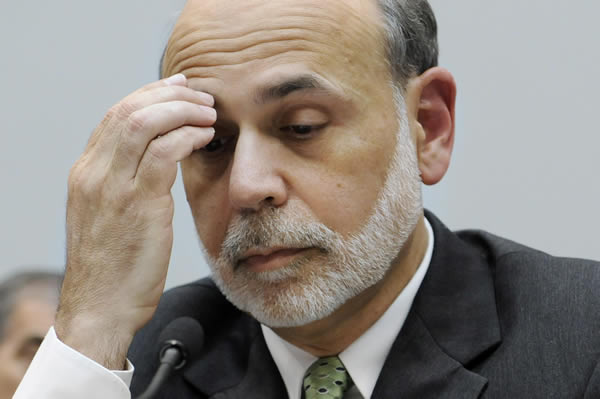Do the risks from the Federal Reserve’s trillion-dollar annual stimulus program justify the rewards? That was the central question at Tuesday’s Senate Banking Committee hearing featuring Fed chairman Ben Bernanke.
Bernanke worked hard to defend the Fed’s quantitative easing policy, but he appears to oversell the rewards by a mile and understate the risks by leagues.
The Daily Signal depends on the support of readers like you. Donate now
At issue is the Fed’s announced policy of buying—indefinitely—$85 billion in Treasury bonds and other long-term securities every month to push down long-term interest rates. Why? Because there is really nothing else the Fed can do to stimulate Obama’s sluggish economy. Massive deficit spending has proven once again massively ineffective. Yet the traditional monetary policy of reducing short-term interest rates was rendered obsolete when these rates effectively hit zero.
Bernanke noted that high unemployment is expected to persist and that “high unemployment has substantial costs, including not only the hardship faced by the unemployed and their families but also the harm done to the vitality and productive potential of our economy as a whole.” Exactly right. A more concise, independent condemnation of President Obama’s economic policies would be hard to find.
Bernanke also noted how ultra-low long-term interest rates are benefitting the economy by facilitating the housing recovery while encouraging consumer spending on durables like cars and providing impetus to business investment. All true, but not quite on point. Low interest rates are helpful under the circumstances, but to what extent are these low rates the result of Fed policy?
No one knows, but the United States is not the only country with low interest rates. Most industrialized countries that are not in or near a debt death spiral like Greece or Italy are experiencing low interest rates. The 10-year Treasury bond rate remains below 2 percent, but so too do interest rates on comparable securities issued by Germany, the United Kingdom, and Japan.
Accepting that the Fed is pushing down rates somewhat, the effect today is likely slight, so instead of a 3.7 percent 30-year mortgage, borrowers get perhaps 3.5 percent. Helpful, but not very. And if very low rates themselves cannot overcome Obama’s policies, there’s no reason to suspect that slightly lower rates would do so, and indeed they haven’t, as Bernanke’s own testimony affirms.
Then there are the risks Bernanke works so hard to dismiss, the most commonly cited being future high inflation. Bernanke is probably right to give this concern short shrift, but take care not to dismiss it entirely. As long as Fed policy is to maintain low and stable inflation, then even when it errs, the mistakes would be correctible. But in the U.K. the central bank is increasingly making noises about tolerating temporarily above-target inflation. Might the Fed follow the Brits?
A greater risk is to the Fed itself. Once interest rates begin to rise, the effects on the financial condition of the Fed itself would be severe. The mechanics are simple enough—when interest rates go up, the market value of bonds goes down, and the longer the maturity the bond, the greater the effect. The average maturity of assets held by the Fed is estimated at nearly 11 years. What really happens when the Fed’s assets drop substantially in value relative to its liabilities? No one really knows, because this is unprecedented. Bernanke assures us that it’s a non-event, but his former ally and Fed colleague Fred Mishkin argues forcefully to the contrary.
The greater risk yet is to the economy itself when the Fed has to sell off the trillions in securities it purchased. It bought securities when markets are soft and rates are low; it will be selling when markets are much tighter and interest rates are rising fast through the normal recovery process magnified by the even higher rates that will follow from increasing the federal debt share from the traditional 40 percent of the economy to the mid-70s. Selling these securities will surely push up interest rates by some multiple of the extent to which rates are lower today. This cannot be good for job growth and wages.
One reported exchange from Bernanke’s hearing deserves special note. Senator Bob Corker (R–TN) suggested that the Fed’s policies create a “faux wealth effect.” Bernanke quickly denied the charge, but Corker was right. If interest rates are artificially low by some amount due to Fed policies, as Bernanke insists, then asset values must be artificially higher, which is, indeed, one of the transmission mechanisms by which Fed policy is supposed to stimulate the economy: Higher asset values means more wealth, which means more consumption, which means more economic growth.
But Bernanke promises that the policy is temporary. And so the wealth effect is both artificial and temporary. It is a faux wealth effect, just as Corker is reported to observe, but it gets worse. When the Fed unwinds its policy, sells off assets, and artificially and temporarily drives up interest rates, the faux wealth effect will not only disappear but will reverse: lower asset values, less wealth, less consumption, less economic growth.
Bernanke clearly believes Fed policy is correct, the rewards justifying the risks, and that in the future the Fed will navigate these turbulent, virgin waters with brilliance and aplomb. His views are apparently shared by many but not all Fed Board members and staff. As there seems that nothing can be done to dissuade them, we must all hope they are correct. But there are very good and strong reasons to believe that they are not and that a combination of wishful thinking, soft-heartedness, and hubris is now planting the seeds for a huge harvest of major troubles in the years ahead.































